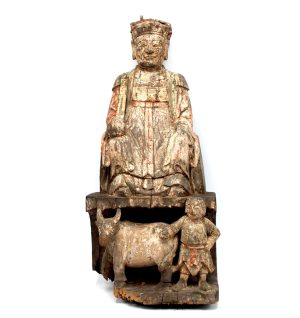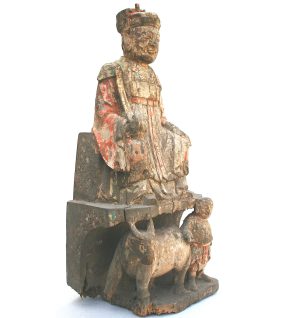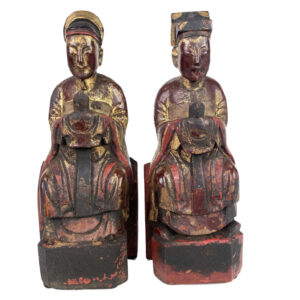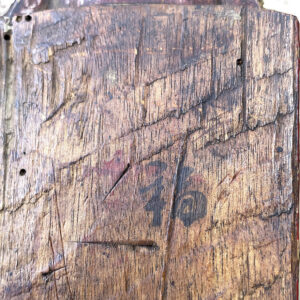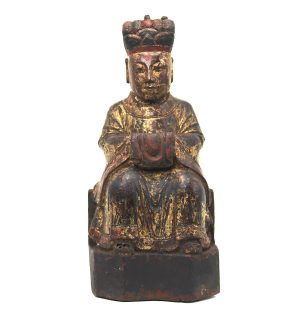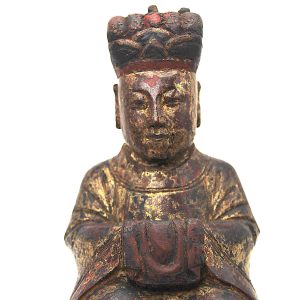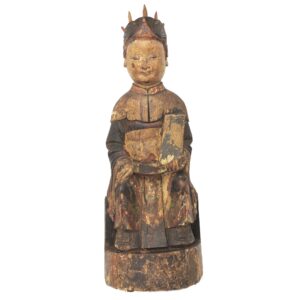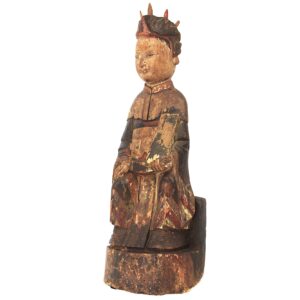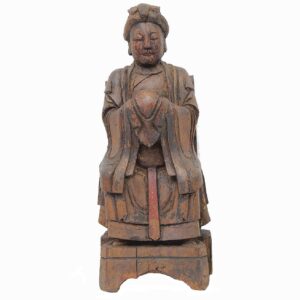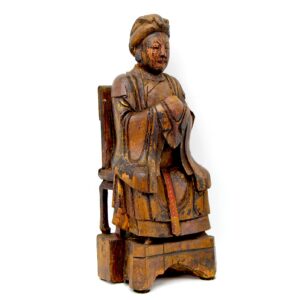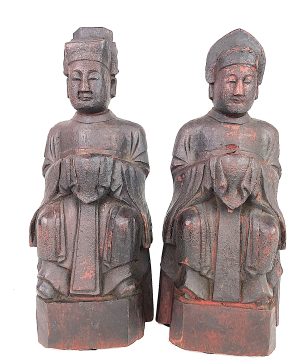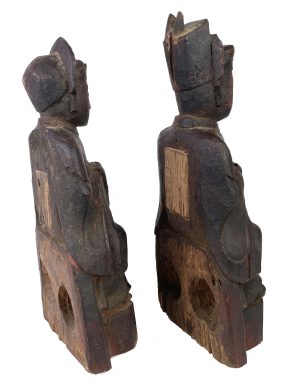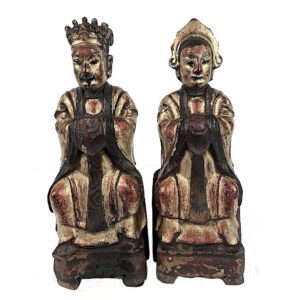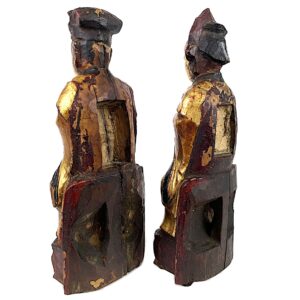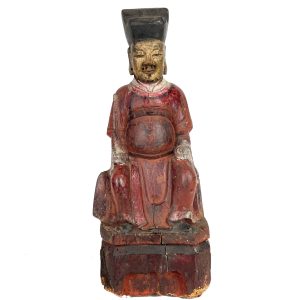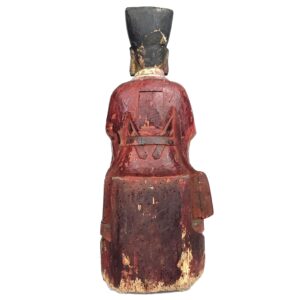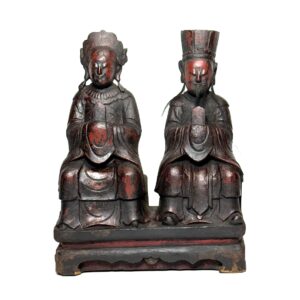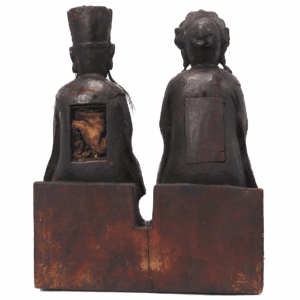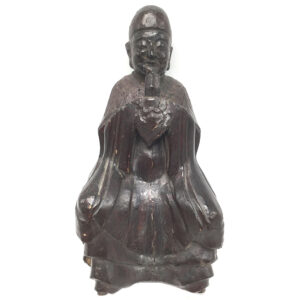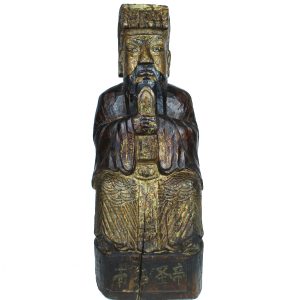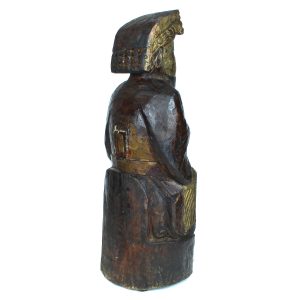-
Sale!


$885.00 Original price was: $885.00.$650.00Current price is: $650.00.
H: 14.25″ W: 7.125″ D: 4.8″ | FREE SHIPPING WITHIN CONTINENTAL U.S.
Extremely rare provincial carving with a Taoist official on top above the legendary “Spring Ox,” accompanied by the Taoist Earth God “Herd Boy” who each spring ritually “wakes up the earth” by symbolically beating the Spring Ox with sticks.
-
Sale!


$850.00 Original price was: $850.00.$650.00Current price is: $650.00.
H: 7.5″ W: 2.875″ D: 2″ | FREE SHIPPING WITHIN CONTINENTAL U.S.
VA’s most unique and finely crafted Kitchen God couple. Beautifully carved, clasping hu tablets, approachable features, smiling lips. Painted character on base wish for “happiness.” Add positive chi, enhance feng-shui.Unique house warming/wedding gifts.
-
Sale!


$350.00 Original price was: $350.00.$250.00Current price is: $250.00.
H: 9.25″ W: 4.5″ D: 3.25″ | FREE SHIPPING WITHIN CONTINENTAL U.S.
Taoist official home altar carving painted on front and back with red, gilt and lacquer. Hands under ritual cloth symbolically holding a hu tablet associated with Taoist officials. Taoist were responsible for protecting against evil in this life, Buddhist for souls in next life.
-
Sale!


$495.00 Original price was: $495.00.$325.00Current price is: $325.00.
H: 12 ” W:4.3 ” D: 2.25 ” | FREE SHIPPING WITHIN CONTINENTAL U.S.
Charming consecrated image of female Toast priest with Phoenix headdress holding a hu tablet. Women were welcomed as priests since Taoism beginnings.
-
Sale!


$425.00 Original price was: $425.00.$225.00Current price is: $225.00.
H: 9” W: 6.525” D: 2.5 | FREE SHIPPING WITHIN CONTINENTAL U.S.
Small consecrated home altar provincial Mazu, finely carved on armless back chair dressed modestly in peasant robes with a phoenix in her hat, she is motherly figure who protects her devotees as her children.
-
Sale!


$695.00 Original price was: $695.00.$525.00Current price is: $525.00.
H: 7.25 ” W: 3 ” D: 1.625 ” | FREE SHIPPING WITHIN CONTINENTAL U.S.
Finely carved Kitchen God and his wife, mirror images on backless chairs with multi-sided pedestals reflecting reverent and responsibility to protect the home. Naturally darkened lacquer, soft patina. Male with consecration covering, female open with contents. Unique house warming/wedding gift.
-
Sale!


$695.00 Original price was: $695.00.$525.00Current price is: $525.00.
H: 7.75 ” W: 2.875 ” D: 1.875 ” | FREE SHIPPING WITHIN CONTINENTAL U.S.
Husband and wife Kitchen Gods are near mirror images with similar layered gold officials’ robes, clasped hands covered in ritual cloth. Excellent condition, fine patinas. Consecration script remaining in wife’s cavity but not in husband’s.
-
Sale!


$875.00 Original price was: $875.00.$495.00Current price is: $495.00.
H: 15.5″ W: 6.125 ” 4.125 D: ” | FREE SHIPPING WITHIN CONTINENTAL U.S.
Carved ancestor figure as an official sits on a backless chair with a decorative pedestal in official’s attire holding a long slender curved hu-tablet, all signs of his office and status. He is vibrantly painted in red, the color of fu, as a wish for prosperity and status.
-
Sale!


$995.00 Original price was: $995.00.$695.00Current price is: $695.00.
H: 10″ W: 7.75″ D: 8.25″ | FREE SHIPPING WITHIN CONTINENTAL U.S.
Rare single image of Kitchen God and wife, indicating their close/lasting relationship as family’s protectors. Detailed elaborate officials’ robes, headgear. Individually portrayed holding hu tablets like those held by high court officials or Taoist priests.
-
Sale!


$295.00 Original price was: $295.00.$215.00Current price is: $215.00.
H: 10.5″ W:5″ D: 4″ | FREE SHIPPING WITHIN CONTINENTAL U.S.
Taoist official/priest on backless chair, arms at chest and hands covered by ritual cloth symbolically holding a hu tablet. Darkened by incense and candle smoke from ritualistic offerings it was re-lacquered probably in early 20th-century.
-
Sale!


$395.00 Original price was: $395.00.$295.00Current price is: $295.00.
When ancestral images are taken out of context they are very difficult to identify so we describe them in generic terms as a Chinese Officials or Taoist Officials. This carving may represent the noted historical figure the principal regent Dorgon of the first Qing Emperor Shunzhi who ruled from 1643-1650 as a”quasi” emperor based on…
End of content
End of content

